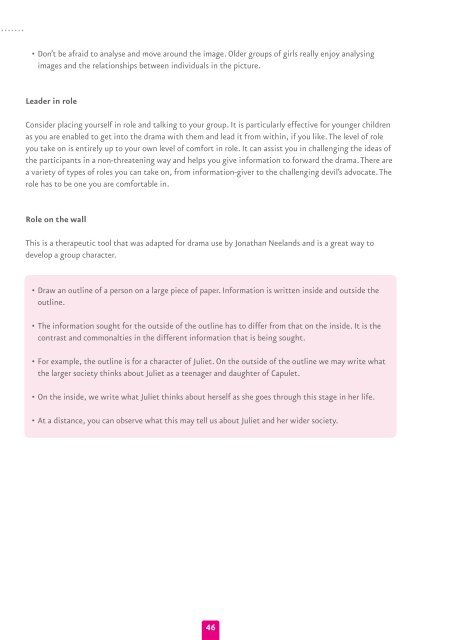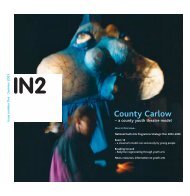DRAMA SPACES - Youth Arts Programme
DRAMA SPACES - Youth Arts Programme
DRAMA SPACES - Youth Arts Programme
You also want an ePaper? Increase the reach of your titles
YUMPU automatically turns print PDFs into web optimized ePapers that Google loves.
dramaspaces6 18/8/05 4:25 PM Page 46• Don’t be afraid to analyse and move around the image. Older groups of girls really enjoy analysingimages and the relationships between individuals in the picture.Leader in roleConsider placing yourself in role and talking to your group. It is particularly effective for younger childrenas you are enabled to get into the drama with them and lead it from within, if you like.The level of roleyou take on is entirely up to your own level of comfort in role. It can assist you in challenging the ideas ofthe participants in a non-threatening way and helps you give information to forward the drama.There area variety of types of roles you can take on, from information-giver to the challenging devil’s advocate.Therole has to be one you are comfortable in.Role on the wallThis is a therapeutic tool that was adapted for drama use by Jonathan Neelands and is a great way todevelop a group character.• Draw an outline of a person on a large piece of paper. Information is written inside and outside theoutline.• The information sought for the outside of the outline has to differ from that on the inside. It is thecontrast and commonalties in the different information that is being sought.• For example, the outline is for a character of Juliet. On the outside of the outline we may write whatthe larger society thinks about Juliet as a teenager and daughter of Capulet.• On the inside, we write what Juliet thinks about herself as she goes through this stage in her life.• At a distance, you can observe what this may tell us about Juliet and her wider society.46






